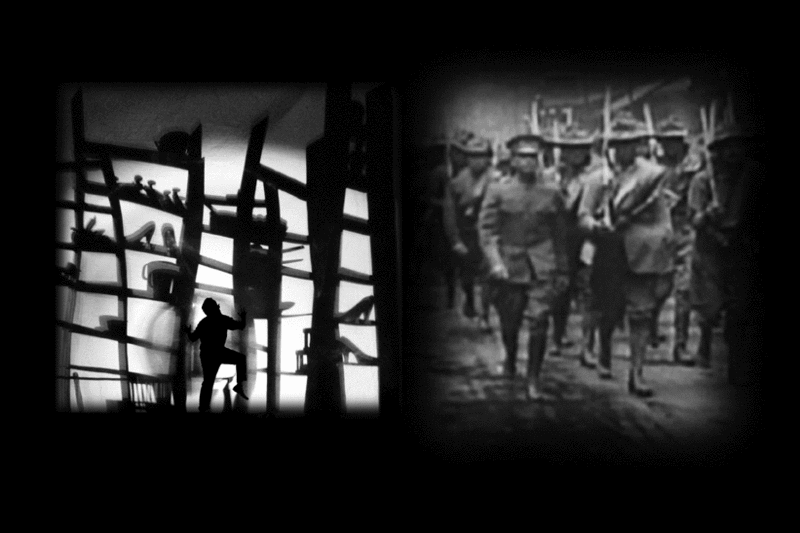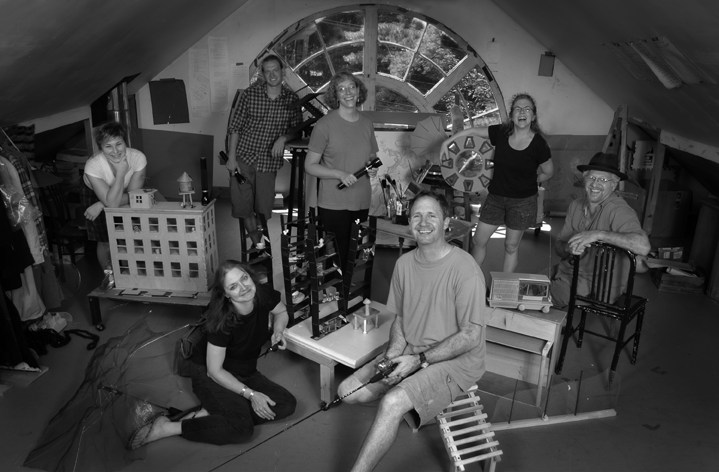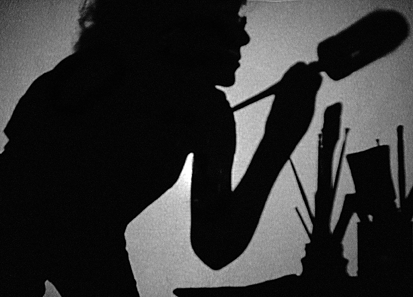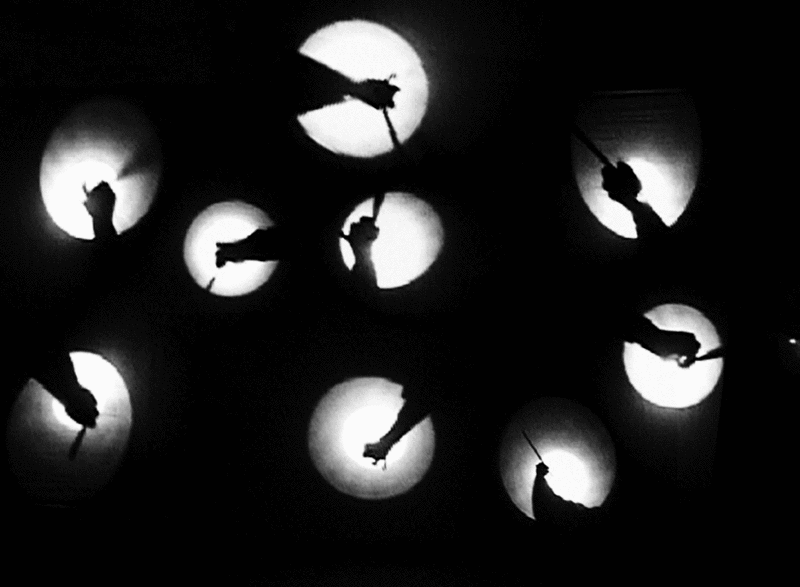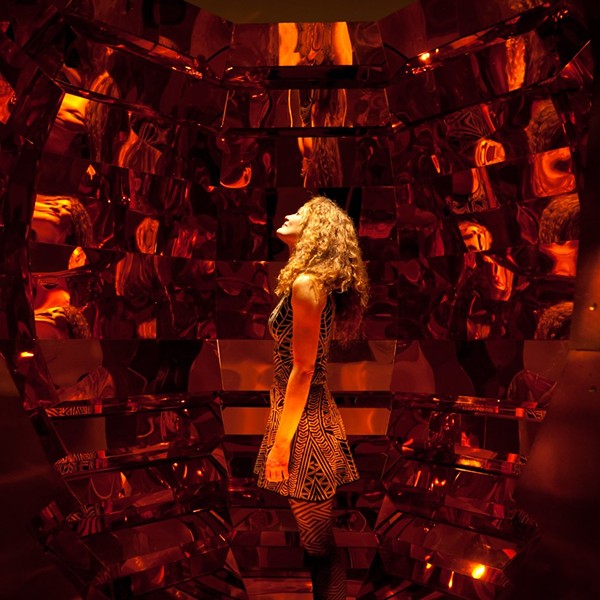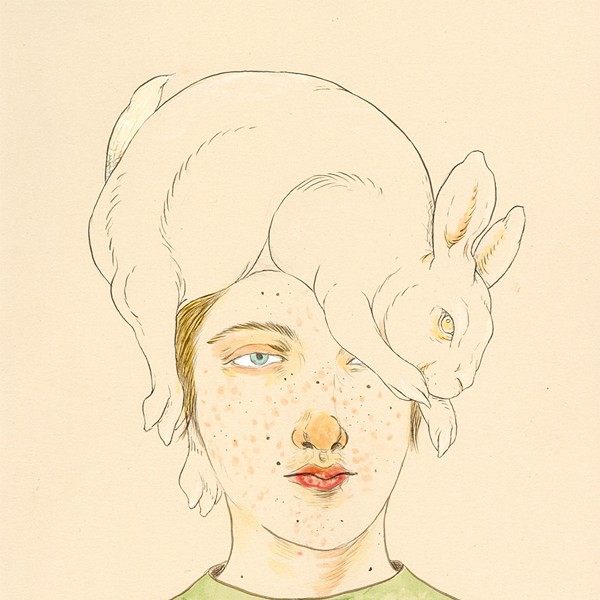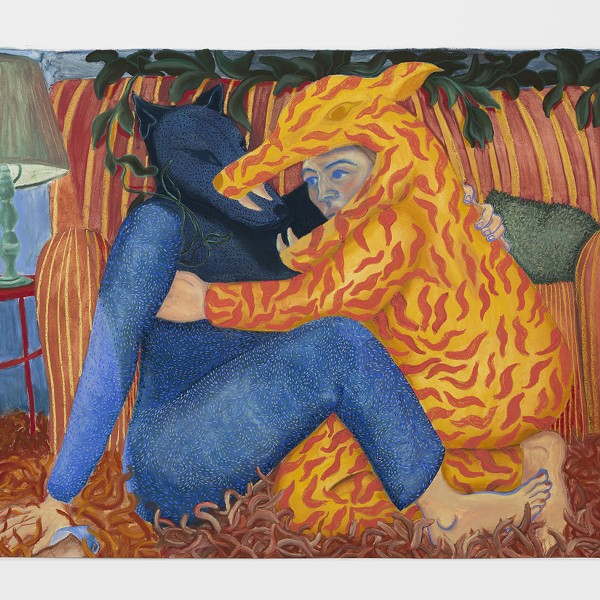The name Cave Dogs summons all sorts of possible references—from the ancient Latin cave canem (beware of dog), to Plato’s Allegory of the Cave (especially since the group works extensively with shadow play), to some pack of feral canines holing up in a cave. In reality, this collaborative group of artists, musicians, writers, and performers began in 1991 with a shadow play performance in Rosendale’s Widow Jane Mine (the Cave), directed by the then recent SUNY New Paltz MFA graduate Suzanne Stokes. That first show premiered as Cave Core, but Stokes broke away from that group shortly thereafter to form Cave Dogs, generating six new productions in the years since.
Although the new moniker was chosen largely by chance, the felicitous layering of meanings and images that it carries with it aptly describes the group’s complex collaborative performances, which combine sculpture, painting, shadow puppetry, music, and video projections on a large theatrical scrim. An overload of sight and sound, their most recent piece, “Archeology of a Storm,” creates an elliptical, allusive journey through multiple generations of residents in a New York City apartment building, raising questions about history, legacy, and politics. This work will appear as part of the Kingston Sculpture Biennial 2007 in an open air performance in Hasbrouck Park on Friday, October 5 at 8pm. Bring a blanket or a lawn chair, and decide for yourself what it all means.
Cave Dogs on Their Work
Current personnel in the group include: Suzanne Stokes, James Fossett, Michelle Hughes, Dan Getman, Jeremy Holmes, Tracy Leavitt, and Amy Schoonover. Individual speakers are identified by their initials.
What is it?
SS: “Archeology of a Storm” is about legacy and what we leave behind us—physically, environmentally, conceptually, just everything. So when the war themes came in, it happened as a result of all the rest, just naturally. We didn’t start from a pedantic point about war. I have a problem with that kind of artwork. I didn’t want this artwork to be seen that way. I think there’s a lot more to it than that.
DG: No truly collaborative piece could ever be as simple as that. A collaboration with so many different people, so many things going on, visually, sonically, in shadow and image and acting, projections—it could never be that simple or unitary.
SS: I hesitate to call it performance, because that carries all kinds of connotations with it that the work is absolutely not. But it is performative. I think it’s closer to theater than to anything else, but it doesn’t start that way. It’s started through the visual, and sound. My sound bite, when I’m trying to get a venue, is: “Cave Dogs is a shadow-based theatrical company,” or something like that. Even that doesn’t really cut it. It’s a genre unto itself.
TL: It can’t be just like painting, or sculpture, or a puppet play, or something cut-and-dried like that. It’s all those things, and it’s none of them individually.
DG: And nobody has ever seen anything like it, unless they’ve seen another Cave Dogs piece. Because it doesn’t fit into any of those categories, it’s hard to explain, and hard to understand. It challenges the viewer in a way, as well. How do you look at shadow play like this, when your brain’s never done that before? How do you look at video in relation to that, and what are they saying? There are so many things going on that the viewer has to put together, different from anything they’ve ever experienced before.
SS: People do try to categorize it, but the first 10 minutes of the show they’re just going “What is this?” I don’t have a problem with not having a name for it—only when I’m trying to explain it quickly to somebody.
Genesis of a storm
MH: I live next door to Jim and Suzanne; our kids are close friends. I’ve been writing for a while, mostly for myself, when to my great surprise, Suzanne came to me and asked if I would write this story [“Archeology of a Storm”] for Cave Dogs. It was an amazing process. It took a year and a half to write the play, I think. It was a collaborative venture. The Cave Dogs began to think about some themes—like legacy, what we pass on to the next generation (both positive and negative), and the war had started, 9/11 had happened, it was an emotionally tense time. As we worked on it, it became about community, about family, about this house, and the things left in this house, the legacy of war, and that’s how the story evolved. We read it a number of times as a group, then I’d go back to work on it, and come back—that’s how the character development happened.
It was very funny—I said to Suzanne, “Get with the group, and come up with some themes, and I’ll begin to shape the story from that.” She came back with three pages of visual images! These were all artists, but luckily I have an art background, so that helped me understand what they meant by all that.
AS: When I first joined, I just sat in the back and watched the rest of them run through the piece. Afterward, they asked me what I thought, and I basically just told them the whole story. They were amazed, they couldn’t believe that I got it all. When I saw it, I appreciated the war theme, the family theme, and I liked the way they poked a bit of fun at the administration now. When the Iraq war started, I was in Europe, and there were a few times that I actually said I was Canadian over there. This show really brought back some of those feelings. The more I watched it, the more I got involved, the more I appreciate it.
There’s a lot to focus on at once. The more you see it, the more you can pick up from it. Some of the lines are very subtle, other things slip in. I know some people who were concentrating mostly on the visual side of the show. The shadows are so dimensional, there are things you can miss there as well. Many times as we rehearsed, I would notice lines I hadn’t even heard before, because I was so involved in doing my part. It does take time to hear and to see everything in the story. The music is a big part of it as well. There’s a reason why that song is there, there’s a reason why those words are being said. It’s a sensory overload.
Indirect direction
JF: Everyone [in the group] locks into a different piece of the show, and it’s the same for the audience as well. It’s such a huge sensory overload in both the visual sense and the audio sense, it’s a real challenge to concentrate on both. I think it’s a good challenge, a positive challenge, because you’re trying to connect to so many things. Lots of people come out and say, “I’m not sure what that was about, but I really liked it.” It’s the effect of the effects. Sometimes we try to let it be just about the soundtrack, like a radio experience, or hearing a story told to you, so you can generate some of your own mental images as an audience.
SS: I think the way we work as a group, as a collaborative, and the kinds of fairly serious topics we address—the format we use with the shadow and video projections and the soundtrack—is a nice way to say difficult information. If people can see it and hear it in a different way than just “We shouldn’t be at war” or whatever, it’s just a way of giving information.
DG: The show is just not didactic, or a political show in the sense of having a single point. It’s a layering of history, of multiple generations and the issues that they’re facing. An important part of it for me, coming in after the story was written, the continual evolution and process of matching the shadows to soundtrack, changing the soundtrack to match things we were doing the back, changing the cast which brought new ideas and ways of doing the shadows. There was a continual collaboration with what we’re each doing. It’s an amazingly creative process.
TL: The process itself is a statement which mirrors what I love about what we’re saying. It’s that community that has evolved in that apartment building, that’s what’s important in life. I love the picture, the video of the soldiers in slow motion. You know they’re veterans, and you know that they come into this as well. For me it’s an antiwar statement, but it’s ultimately an affirmation of community.







